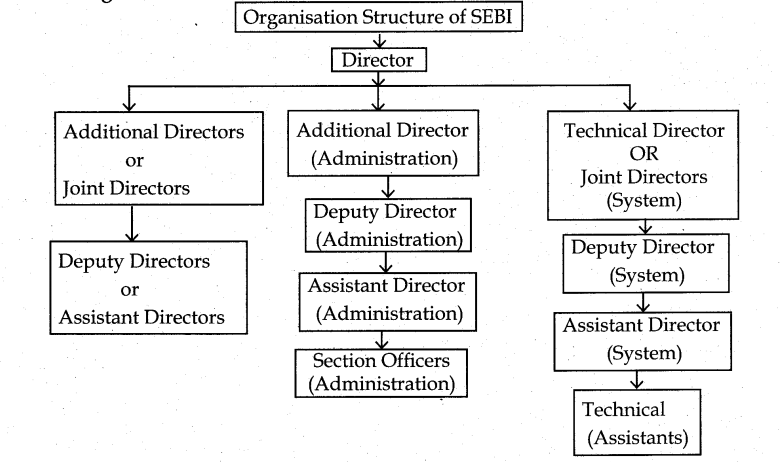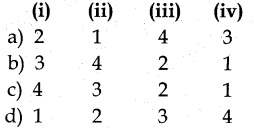Tamilnadu State Board New Syllabus Samacheer Kalvi 12th Commerce Guide Pdf 8 Securities Exchange Board of India Text Book Back Questions and Answers, Notes.
Tamilnadu Samacheer Kalvi 12th Commerce Solutions Chapter 8 Securities Exchange Board of India
I. Choose The Correct Answer.
Question 1.
Securities Exchange Board of India was first established in the year…………………
a) 1988
b) 1992
c) 1995
d) 1998
Answer:
a) 1988
![]()
Question 2.
The headquarters of SEBI is…………..
a) Calcutta
b) Bombay
c) Chennai
d) Delhi
Answer:
b) Bombay
Question 3.
In which year SEBI was constituted as the regulator of capital markets in India?
a) 1988
b) 1992
c) 2014
d) 2013
Answer:
a) 1988
![]()
Question 4.
Registering and controlling the functioning of collective investment schemes as………….
a) Mutual Funds
b) Listing
c) Rematerialisation
d) Dematerialization
Answer:
d) Dematerialization
Question 5.
SEBI is empowered by the Finance ministry to nominate ………………….. members on the Governing body of every stock exchange.
a) 5
b) 3
c) 6
d) 7
Answer:
b) 3
Question 6.
The process of converting physical shares into electronic form is called ………………
a) Dematerialisation
b) Delisting
c) Materialisation
d) Debarring
Answer:
a) Dematerialisation
![]()
Question 7.
Trading is dematerialized shares commenced on the NSE is ………………………
a) January 1996
b) June 1998
c) December 1996
d) December 1998
Answer:
c) December 1996
Question 8.
…………..was the first company to trade its shares in Demat form.
a) Tata Industries
b) Reliance Industries
c) Infosys
d) Birla Industries
Answer :
b) Reliance Industries
![]()
Question 9.
…………….. enables small investors to participate in the investment on the share capital of large companies.
a) Mutual Funds
b) Shares
c) Debentures
d) Fixed deposits
Answer:
a) Mutual Funds
Question 10.
PAN stands for …………………
a) Permanent Amount Number
b) Primary Account Number
c) Permanent Account Number
d)Permanent Account Nominee
Answer:
c) Permanent Account Number
II. Very Short Answer Questions.
Question 1.
Write short notes on SEBI.
Answer:
Securities and Exchange Board of India (SEBI) was first established in the year 1988 as a non-statutory body for regulating the securities market.
![]()
Question 2.
Write any two objectives of SEBI.
Answer:
Control Over Brokers:
The important object is to supervise or check the activities of the Brokers, and other intermediaries in order to control the capital market.
Regulation of Stock Exchange :
- The first objective of SEBI is to regulate the Stock Exchange.
- So that efficient services may be provided to all the parties operating there.
Question 3.
What is a Demat Account?
Answer:
A Demat account holds all the shares that are purchased in electronic or dematerialized form.
![]()
Question 4.
Mention the headquarters of SEBI.
Answer:
Head Quarters – Mumbai [Bandra Kurla – Complex]
 .
.
Question 5.
What are the various ID proofs?
Answer:
Proof of identity: PAN card, voter’s ID, passport, driver’s license, bank attestation, IT returns, electricity bill, telephone bill, ID cards with applicant’s photo issued by the central or state government are the ID proofs.
![]()
III. Short Answer Questions.
Question 1.
What is meant by Dematerialization?
Answer:
- Dematerialization [DEMAT] is the process by which physical share certificates of an investor are taken back by the Company or Register and destroyed.
- Then an equivalent number of securities in the Electronic form is credited to the investor’s account with his Depository Participant. [DP]
- DEMAT is done at the request of the Investor.
- He has to open an account with a DP.
- In DEMAT A/c – Purchase – Credited his account.
- In DEMAT A/ c – Sales – Debited his account
Question 2.
What are the documents required for a Demat account?
Answer:
- For opening a Demat account, we submit proof of identity and address along with a passport size photo and the account opening form.
- Documents for Identity: Pan card, Voters ID, Passport, Driver’s License, IT Returns, Electricity and Telephone Bills are the Identity documents.
- Documents for Address: Ration card, Passport, Voter’s ID card, Driving License, Telephone Bills, Electricity bills are the address documents.
![]()
Question 3.
What is the power of SEBI under the Securities Contract Act?
Answer:
- Power to grant License to the new stock exchange.
- Power to direct any stock exchange to amend the rules.
- Power to supersede governing body of any stock exchange.
- Power to ask for information and accounts of the stock exchange.
- Power to suspend the business of the stock exchange.
- Power to prohibit contracts of the stock exchange.
Question 4.
What is meant by Insider trading?
Answer:
Insider trading means the buying and selling of securities by directors, promoters, etc., who have access to some confidential information about the company. This affects the interests of the general investors and is essential to check this tendency.
Question 5.
Draw the organizational structure of SEBI.
Answer:
Organization Structure of SEBI

IV. Long Answer Questions.
Question 1.
What are the functions of SEBI?
Answer:
functions:
- SEBI is the NODAL agency which safeguards the interests of an investor in the Indian Financial Market.
SEBI performs:

- Safeguarding the interest of the investors by means of adequate education and guidance.
- SEBI makes Rules and Regulations that must be strictly followed by the participants of the financial market.
- Regulating and Controlling the business on Stock Exchange.
- Registration of Brokers and sub-brokers is made mandatory.
- Conduct inspection and inquiries of stock exchanges, intermediaries, and self-regulating organizations.
- Barring insider trading in securities.
- Prohibiting deceptive and unfair methods by intermediaries.
- Registering and Controlling share agents, bankers, trustees, registrars, merchant bankers, underwriters, managers, etc.
- SEBI regulates mergers and amalgamation as a way to protect the interest of the investors. Registering and Controlling the function of collective investment schemes such as mutual funds.
- Promoting self-regulatory organizations intermediaries.
Carrying out steps in order to develop the capital markets by having an accommodating approach.
![]()
Question 2.
Explain the powers of SEBI.
Answer:
The various powers of a SEBI are explained below:
- Powers Relating to Stock Exchanges and Intermediaries: SEBI has wide powers to get the information from the stock exchange and intermediaries regarding their business transactions for inspection.
- Power to Impose Monetary Penalties: SEBI has the power to impose monetary penalties on capital market intermediaries for violations.
- Power to Initiate Actions in Functions Assigned
- Power to Regulate Insider Trading: SEBI has the power to regulate insider trading or can regulate the functions of merchant bankers.
- Powers Under Securities Contracts Act: For the regulation of the stock exchange, the Ministry of Finance issued a notification, for delegating several of its powers under the securities contract Act.
Question 3.
What are the benefits of Dematerialisation? (advantages)
Answer:
Benefits of Dematerialisation:
- The risks relating to physical certificates like loss, theft, forgery are eliminated completely with a Demat Account.
- The risk of paperwork enables quicker transactions and higher efficiency in trading.
- The shares which are created through mergers and consolidation of companies are credited automatically in the Demat account.
- There is no stamp duty for the transfer of securities.
- Certain banks also permit holding of both equity and debt securities in a single account
- A Demat account holder can buy or sell any amount of shares.
![]()
12th Commerce Guide Securities Exchange Board of India Additional Important Questions and Answers
I.Choose the correct answer.
Question 1.
In which year is SEBI Act being passed by the Indian Parliament?
a) 1990
b) 1991
c) 1992
d) 1993
Answer:
c) 1992
Question 2.
…………….. is the foremost objective of SEBI.
a) Security
b) Regulate
c) Control
d) NOTA
Answer:
a) Security
![]()
Question 1.
SEBI got the statutory powers in the year _____
(a) 1988
(b) 1992
(c) 1969
(d) 1980
Answer:
(b) 1992
Question 4.
Which is an Apex body that maintains and Regulates the capital market?
a) Stock Exchange
b) SEBI
c) OTCEI
d) NSE
Answer:
b) SEBI
![]()
Question 5.
Name the three key functions of SEBI.
Answer:
SEBI performs three key functions.
They are:
- quasi-legislative
- quasi-judicial
- quasi-executive
Question 6.
SEBI has the following number of members including the chairman.
a) 4
b) 5
c) 6
d) 7
Answer:
c) 6
![]()
Question 7.
Pick the odd one out:
a) Voter ID
b) PAN
c) ID card
d) PostCard
Answer:
d) Post Card
Question 8.
which one of the following is not correctly matched?
a) DEMAT – Dematerialisation
b) PAN – Proof
c) SEBI -12 members
d) HQ – Bendrakurla
Answer :
c) SEBI -12 members
![]()
Question 9.
Choose the correct statement.
(i) SEBI Act was passed in the year 1992 in Indian Parliament.
(ii) It protects the interest of the Investors.
(iii) It Regulates and controls the stock exchange.
a) (i) is correct
b) (ii) is correct
c) (iii) is correct
d) All (i), (ii) and (iii) are correct
Answer :
d) All (i), (ii) and (iii) are correct
![]()
II. Match the following
Question 1.
|
List-I |
List-II |
| i. SEBI | 1. Dematerialization |
| ii. DEMAT | 2. A Supervisory Body |
| iii. PAN | 3. Buying and Selling by director |
| iv. Insider Trading | 4. Permanent Account Number |

Answer :
a) (i) – 2, (ii) – 1, (iii) – 4, (iv) – 3
![]()
III. Assertion and Reason :
Question 1. Assertion (A): DEMAT is done at the request of the investor.
Reason (R): A DEMAT A/c holder can buy or sell any amount of shares.
a) (A) is True (R) is True
b) (A) and (R) are False
c) (A) is True (R) is False
d) (A) is False (R) is True
Answer :
a) (A) is True (R) is True
Question 2.
Assertion (A): SEBI is a supervisory (Apex) Body.
Reason (R): So, It cannot regulates and control the stock exchange.
a) (A) is True (R) is False
b) (A) is False (R) is True
c) Both (A) and (R) are True
d) Both (A) and (R) are False
Answer :
a) (A) is True (R) is False|
![]()
IV. Very Short answer questions.
Question 1.
Write a note on PAN.
Answer:
PAN, or permanent account number, is a unique 10-digit alphanumeric identity allotted to each taxpayer by the Income Tax Department. It also serves as identity proof.